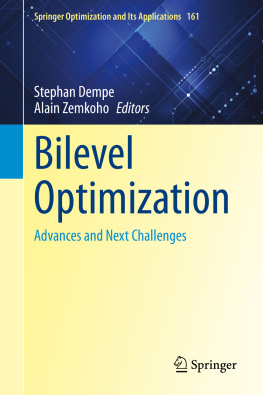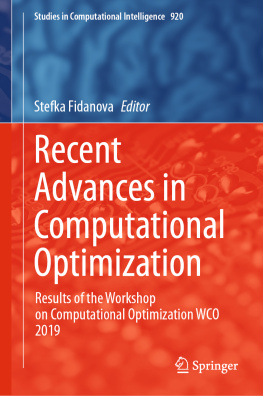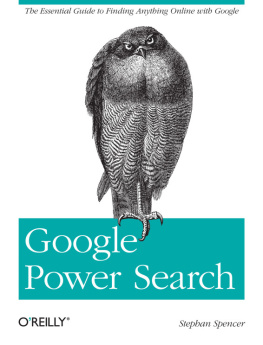Stephan Dempe - Bilevel Optimization: Advances and Next Challenges
Here you can read online Stephan Dempe - Bilevel Optimization: Advances and Next Challenges full text of the book (entire story) in english for free. Download pdf and epub, get meaning, cover and reviews about this ebook. year: 2020, publisher: Springer International Publishing, genre: Home and family. Description of the work, (preface) as well as reviews are available. Best literature library LitArk.com created for fans of good reading and offers a wide selection of genres:
Romance novel
Science fiction
Adventure
Detective
Science
History
Home and family
Prose
Art
Politics
Computer
Non-fiction
Religion
Business
Children
Humor
Choose a favorite category and find really read worthwhile books. Enjoy immersion in the world of imagination, feel the emotions of the characters or learn something new for yourself, make an fascinating discovery.
- Book:Bilevel Optimization: Advances and Next Challenges
- Author:
- Publisher:Springer International Publishing
- Genre:
- Year:2020
- Rating:5 / 5
- Favourites:Add to favourites
- Your mark:
- 100
- 1
- 2
- 3
- 4
- 5
Bilevel Optimization: Advances and Next Challenges: summary, description and annotation
We offer to read an annotation, description, summary or preface (depends on what the author of the book "Bilevel Optimization: Advances and Next Challenges" wrote himself). If you haven't found the necessary information about the book — write in the comments, we will try to find it.
Bilevel Optimization: Advances and Next Challenges — read online for free the complete book (whole text) full work
Below is the text of the book, divided by pages. System saving the place of the last page read, allows you to conveniently read the book "Bilevel Optimization: Advances and Next Challenges" online for free, without having to search again every time where you left off. Put a bookmark, and you can go to the page where you finished reading at any time.
Font size:
Interval:
Bookmark:

Aims and Scope
Optimization has continued to expand in all directions at an astonishing rate. New algorithmic and theoretical techniques are continually developing and the diffusion into other disciplines is proceeding at a rapid pace, with a spot light on machine learning, artificial intelligence, and quantum computing. Our knowledge of all aspects of the field has grown even more profound. At the same time, one of the most striking trends in optimization is the constantly increasing emphasis on the interdisciplinary nature of the field. Optimization has been a basic tool in areas not limited to applied mathematics, engineering, medicine, economics, computer science, operations research, and other sciences.
The series The seriesSpringer Optimization and Its Applications (SOIA) aims to publish state-of-the-art expository works (monographs, contributed volumes, textbooks, handbooks) that focus on theory, methods, and applications of optimization. Topics covered include, but are not limited to, nonlinear optimization, combinatorial optimization, continuous optimization, stochastic optimization, Bayesian optimization, optimal control, discrete optimization, multi-objective optimization, and more. New to the series portfolio include Works at the intersection of optimization and machine learning, artificial intelligence, and quantum computing. aims to publish state-of-the-art expository works (monographs, contributed volumes, textbooks, handbooks) that focus on theory, methods, and applications of optimization. Topics covered include, but are not limited to, nonlinear optimization, combinatorial optimization, continuous optimization, stochastic optimization, Bayesian optimization, optimal control, discrete optimization, multi-objective optimization, and more. New to the series portfolio include Works at the intersection of optimization and machine learning, artificial intelligence, and quantum computing.
Volumes from this series are indexed by Web of Science, zbMATH, Mathematical Reviews, and SCOPUS.
More information about this series at http://www.springer.com/series/7393

This Springer imprint is published by the registered company Springer Nature Switzerland AG.
The registered company address is: Gewerbestrasse 11, 6330 Cham, Switzerland
Bilevel optimization refers to the area of optimization dealing with problems having a hierarchical structure, involving two decision-makers: a leader and a follower. This problem originated from the field of economic game theory and was introduced in the habilitation thesis of Heinrich Freiherr von Stackelberg (October 31, 1905, Moscow to October 12, 1946, Madrid) completed in 1934. This thesis, written in Cologne, on market structure and equilibrium (in German language: Marktform und Gleichgewicht) was published in the same year by Julius Springer, Berlin and Wien [8]. An English translation of the thesis was published in 2011 by Springer [9].
One of the central topics in von Stackelbergs habilitation thesis is a model of duopoly, now known as Stackelberg game. About 50 years later, mathematicians renamed the model into the bilevel optimization (or as synonym bilevel programming [1]) problem and its quick development within mathematical optimization started into different directions. One of the initial points of attention was the realization that the problem is not well-posed if the followers decision is not uniquely defined. Another issue resulted from different possibilities to transform the bilevel problem into single-level problems, which are not necessarily equivalent to the original one. It might be worth to note that later on, two-level (as a synonym for bilevel) optimization was one of the initial sparks of non-differentiable optimization.
Nowadays, bilevel optimization has further developed into a wide number of different directions (finite and infinite dimensional problems, instances with one or many objective functions in the lower- and/or upper-level problem, as well as problems with discrete or continuous variables in one or both levels). Although we can find deterministic algorithms as well as metaheuristics suggested to solve those problems, the bilevel optimization problem itself is NP-hard. The problem has a huge number of applications, and there is now a strong interaction between bilevel optimization theory and related applications.
Font size:
Interval:
Bookmark:
Similar books «Bilevel Optimization: Advances and Next Challenges»
Look at similar books to Bilevel Optimization: Advances and Next Challenges. We have selected literature similar in name and meaning in the hope of providing readers with more options to find new, interesting, not yet read works.
Discussion, reviews of the book Bilevel Optimization: Advances and Next Challenges and just readers' own opinions. Leave your comments, write what you think about the work, its meaning or the main characters. Specify what exactly you liked and what you didn't like, and why you think so.


![Stephan Orth - Behind Putin's Curtain: Friendships and Misadventures Inside Russia [aka Couchsurfing in Russia]](/uploads/posts/book/860709/thumbs/stephan-orth-behind-putin-s-curtain-friendships.jpg)










